The Unlikely Marriage of Sustainability and IIoT
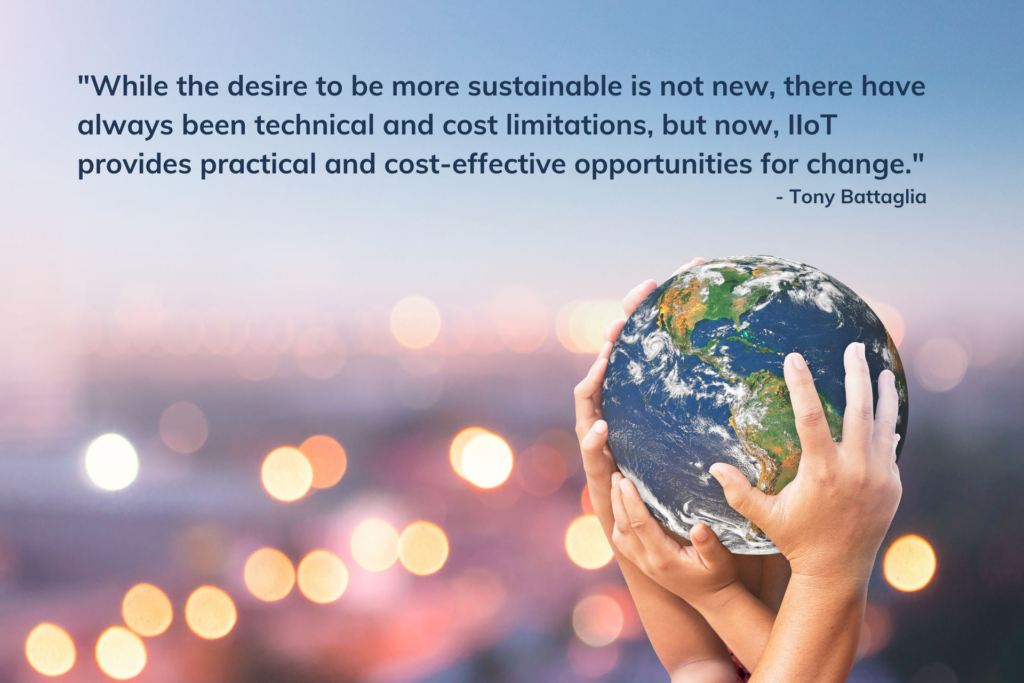
When I think about technology’s impact on sustainability, I think about home. I live in California, and earlier this year there was a fire in my area which, unfortunately, destroyed a lot of houses and affected many families. Luckily, because my city deployed industrial internet of things (IIoT) solutions for fire protection services, they were able to detect this fire early on and prevent further damage in the area. In this scenario, IIoT solutions provided timely insights which allowed the appropriate resources to respond faster, creating a better and safer future for my community. The unlikely pair Sustainability is a widespread conversation these days, and for good reason – a more environmentally conscious world equals better quality of life for us all. As such, electric cars are on the rise, paper straws are everywhere and many companies are doing their part to minimize their carbon footprint. As a collective, we are making great strides in our attempt to create more eco-friendly communities. Amidst our best efforts, however, many may not realize the positive and profound role modern technology, specifically IIoT, can have on our journey towards a greener society. This may come as a surprise, but now more than ever, IIoT is playing a key role in realizing our sustainability goals. Real-world change Today, IIoT technology is completely enhancing our approach to transformative environmental practices by providing the power of response. By implementing IIoT into our data, we can do much more than just monitor data; we can actually respond to data by pulling trends, sending out alerts, leveraging artificial intelligence and so much more. IIoT allows us to take data-driven action, and this is ultimately having a significant impact on the environment and entire industries across the globe. Industry-wide impact In 2015, The United Nations Member States all adopted the 2030 Agenda for Sustainable Development. This global partnership calls countries into action to create a stronger planet by implementing eco-friendly strategic practices to achieve 17 different Sustainable Development Goals (SDGs). Technology plays a significant role in realizing these SDGs. In fact, there are a variety of industries becoming more sustainable because of IIoT. Let’s look at energy, for example. Recently, the energy space began implementing environmental and social governance (ESG) criteria. Now, different organizations can receive access to various federal funds depending on their ability to meet ESG standards. Without the use of IIoT practices, procedures and functions, these organizations could not make the improvements needed to contribute to their environmental goals. With the use of IIoT, these same companies can effectively monitor and manage environmental assets through automated procedures that contribute to more efficient industries and remote work environments across the board. Ultimately, IIoT technology offers the insight and practical solutions needed for these companies to create positive structural changes. The benefits don’t stop there. We’ve all heard or read that our water supply is endangered, and this is not just a California issue, like many assume; it’s a widespread problem that needs immediate attention. The rapid rate of water decrease is not just a byproduct of human consumption, it is also a direct result of everyday processes, industrialization and the ever-changing climate. Today, IIoT products are providing simple solutions to monitor timely data metrics like rainfall rate and water consumption. These solutions respond to water shortages and water waste in innovative ways. Through IIoT, we now have the ability to adjust and adapt our behaviors based on data visualizations, and throughout the process, greater sustainability is achieved worldwide. The IIoT difference on finite resources With sustainability, the goal is really to manage the lifespan of an existing asset, be it drinking water, livestock, oil and gas, the list goes on, and with IIoT technology, we can better control our ability to manage these assets. While the desire to be more sustainable is not new, there have always been technical and cost limitations, but now, IIoT provides practical and cost-effective opportunities for change. At FreeWave Technologies, we’re committed to improving life’s essentials through Industrial IoT solutions. Our full line of connected IIoT network solutions bring most needed data to operations teams wherever they are and our ready-to-deploy solutions play a significant role in environmental monitoring ultimately leading to safer and more sustainable communities. When it comes to Environmental IoT™ we are spearheading a new way forward, offering solution-based products that empower industrial leaders to manage their assets simply and intentionally. Our single pane of glass dashboard creates a singular view for our customer, allowing them to track, control and respond to timely data metrics in one place instead of multiple dashboards across applications. Products that solve problems are important, and that’s exactly what we’re providing at FreeWave. We’re shifting the culture of sustainability from altruism to action, and it’s making a substantial difference. At the end of the day, I care about the world that I’m leaving for the next generation. Every day I think about my two children and the world they’ll grow up in; I want to do my best to create a place where they can thrive, and I’m excited to be a part of an organization that is achieving just that.
Technology’s Impact on Air Quality Control Monitoring
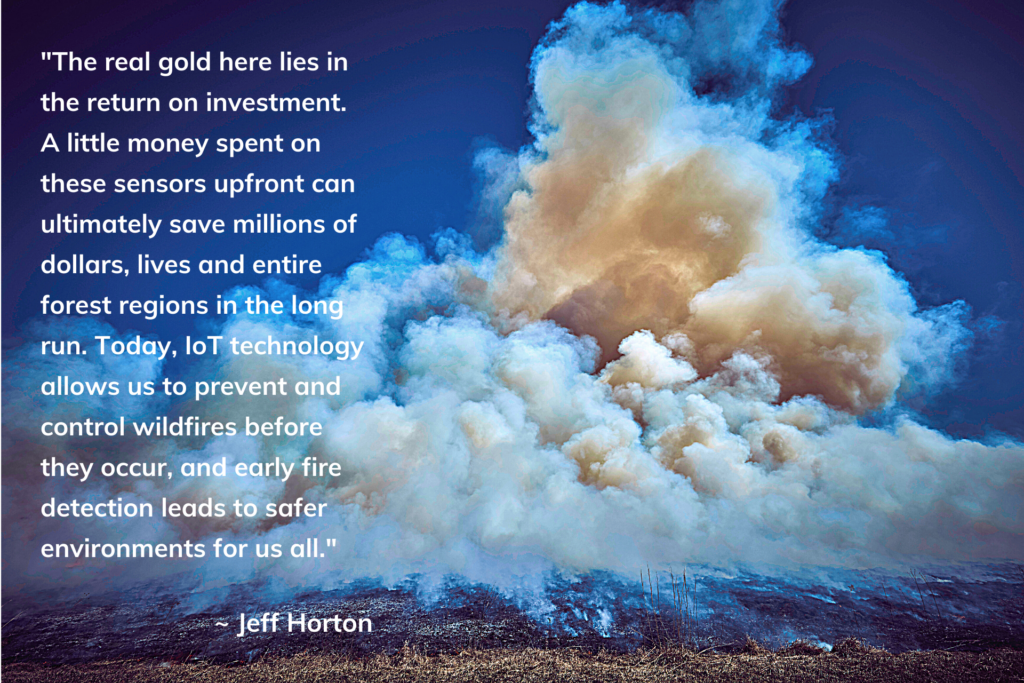
At this very moment, wildfire season is currently underway in North America, and since the start of this year alone, more than 27,000 wildfires have consumed nearly two million acres according to the National Interagency Fire Center (www.nifc.gov). Though many people hear the word “wildfire” and immediately picture a forest in California, the reality is these natural disasters are prevalent across the country. Wildfires are everywhere The Verge, a technology news website, announced recently that roughly 56% of homeowners in the United States face some sort of wildfire risk in the upcoming decades. Bottom line: wildfires are becoming more prevalent and costly every day, and these fires are affecting more than half the population and significantly changing our quality of life. Just a few decades ago, we didn’t have the technology to prevent or predict changes in the surrounding air quality, but now we do, and through it, we can create a better world. Today’s technological advancements allow us to be proactive rather than reactive when it comes to our overall health and safety. By leveraging sensor technology, we have a better chance of predicting and preventing significant changes in the environment, like a drastic shift in air quality before a wildfire begins. This insight allows us to make better decisions based on intentional insights, and our increased access to data provides us with the right information to better control our surrounding environments. Technology is powerful, and this power can and should be used to our advantage. One of my favorite ways to witness the power of technology transforming real-world issues is by exploring the ways sensor technology has a tremendous impact on air quality control monitoring. Today, internet of things (IoT) technology and satellite are the best tools for early detection and prevention of wildfires. Our approach to air quality control Believe it or not, air quality has as much impact on the world as the daily temperature. With climate change causing drastic shifts in the environment, it’s important that we pay close attention to the quality of the air we breathe, as it affects our overall quality of life. As you know, trees play a critical role in our ecosystem, so we must be very intentional and proactive about protecting the forests around us. This is where sensor technology makes a big difference. With a small machine, we can now track and predict changes in the environment and our surrounding air quality, which ultimately helps us control, prevent and predict conditions that lead to wildfires. At FreeWave, we provide autonomous sensors that are strategically placed in remote locations to track and record relevant data metrics such as temperature, humidity, wind, direction and particulate matter. These readings help industry experts know what’s in the air and how the air is changing. Once this data is collected and transmitted to the cloud, we are then able to analyze it and provide alert and proactive responses where needed. We have created a single pane of glass approach, where anyone with access can log into a portal and see in real-time what is happening in the areas surrounding their deployed sensors. The interesting thing about our sensors is that they are fully powered by solar energy, and satellite signals transmit the recorded data. We are basically offering a “buy, install and forget” resource that makes life significantly easier for industry and environmental experts. There is a ton of value here. Not only are we taking an in-depth look at what’s going on in the environment through air quality control monitoring, but we are also taking that information and transforming it into action. The real gold here lies in the return on investment. A little money spent on these sensors upfront can ultimately save millions of dollars, lives and entire forest regions in the long run. Today, IoT technology allows us to prevent and control wildfires before they occur, and early fire detection leads to safer environments for us all. A unique human aid We are making life simpler and safer for all by using technology to do what humans can’t. Back in the day, people had to sit in an operation tower for hours, looking out to catch any major changes in the environment. Today, there is a major shortage of people willing to do this kind of work, and can you blame them? As humans, we can only be in one place at a time doing one thing at a time, but with technology, this is not the case. With simple sensors, we can now monitor and control a lot more environments at a much more affordable rate. All this to say, the goal here is not to replace humans with technology as some might think; what we are really doing is enhancing human ability through the power of technology. I’ve worked in technology for over 30 years, and every day I witness its evolution. I know it’s hard to imagine a world without cell phones, but I can still clearly recall the days when cell phones took up the entire trunk of a car, and now look at the world, most of us carry the same ubiquitous smartphone in our pockets. Technology is amazing, and we have the opportunity to use it to our advantage. At FreeWave, we are taking the capabilities of mobility – LTE, 4G, Satellite, Wi-Fi, Bluetooth, 900 MHz– and marrying them with sensors. The data we gain from these sensors is saving us time, money and resources. At the end of the day, we’re taking away the need to “overthink” industry issues, like how to better prevent forest fires, and instead are replacing our questions with data-informed predictions and timely proactive responses. Every day, we strive to provide industry leaders with the tools and technology needed to spearhead faster and safer environments for us all. This is certainly not a boring business, and I thoroughly enjoy working for a company that is using technology to have an impact on the things that matter most.
Got Data? Now what?
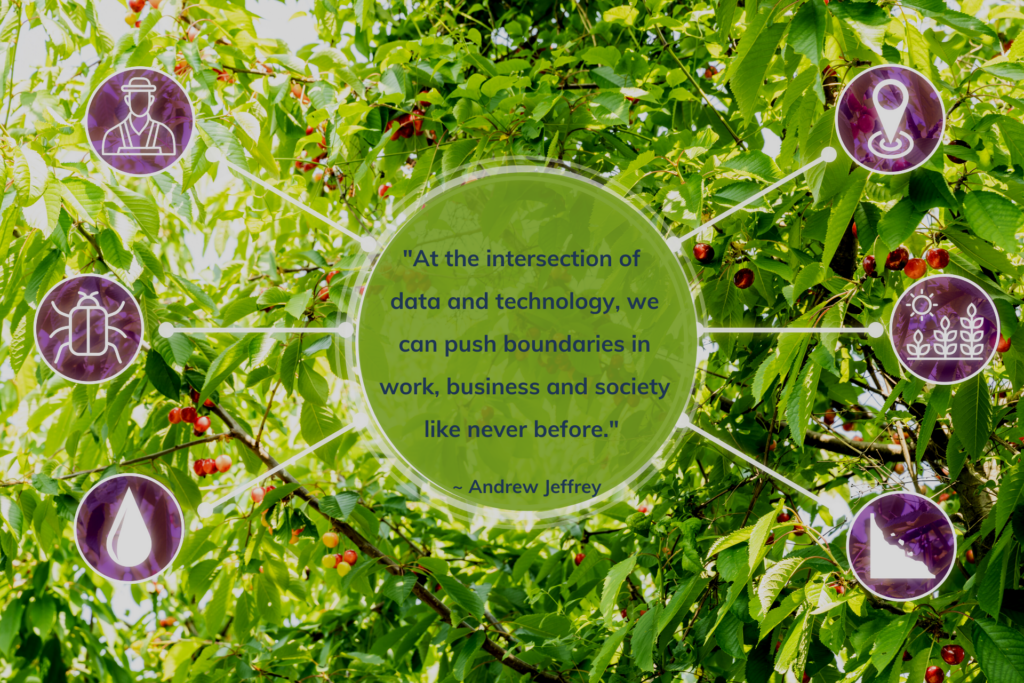
It’s hard to imagine a world without the daily convenience of modern technology. Just yesterday, I joked with my kids about the world before the internet – a time when we actually had to go to the library to look up unknown information. I can still remember the early days of my college career back in the late 90s, the internet had just come out, and we were all getting used to this new phenomenon called a “search engine.” Life has drastically changed over the last 25 years. Now, nearly all the information we want and need is at our fingertips. Today, we have more access to data than most people know how to handle. Data is all around us, collected through the day-to-day actions and reactions of our lives. When we take the time to intentionally analyze, interpret and distribute the data metrics available to us, we can make smarter and more efficient decisions. There is so much to explore, and while our increased access to data is pretty interesting, the reality is that the combination of data and modern technology can change the world. Like many things, though, there are two sides. Sure, industrial companies can capture huge amounts of data, but it also raises the question: now what? How do you put all that data to work? Breaking barriers and pushing boundaries At the intersection of data and technology, we can push boundaries in work, business and society like never before. Data insights allow us to be more precise and accurate in our day-to-day work, which allows us to be more effective and efficient. The operational benefits here are endless, including improved quality control, reduced energy consumption, enhanced safety and increased operational consistency. Just take a look at the food industry, for example. Many field workers in smart agriculture rely heavily on data insights to control, predict and create the best environments for quality crops and harvest. The more accurate their predictions, the better their harvest, and the better their harvest, the faster we receive our food through the supply chain. Today, internet of things (IoT) technology can connect remote and mobile assets, like a tractor, for instant data access, making it easier for farmers to be more efficient and effective in their work. It’s really amazing when you think about it. Data is transforming how we operate in this world, creating better environments for us all. The FreeWave impact At FreeWave, we are constantly pushing the boundaries of technology to create faster, smarter and more efficient work environments. I’ve been a part of the FreeWave team since 2019, and I am constantly amazed at the ways our technology provides innovative solutions for real-world issues. Our products enable our customers to improve their work processes, and through our single pane of glass approach, we offer a simplified experience for businesses and industry leaders to receive automated technology that transforms data metrics into real-time execution. One of my favorite use cases to discuss is FreeWave customer that uses drone technology to deliver food and other valuable resources to far-reaching areas across the globe. With FreeWave products, they can run a smarter and more efficient operation. Their robotics delivery system is combating many of the complex access challenges the world faces on a daily basis. Our IoT technology is helping them solve complex issues with simplified tech solutions, and simple solutions create more time, energy and space to focus on what matters most: people. If you need a product to help you bridge the gap between technology and data, FreeWave is your solution. We are enablement partners, helping every one of our customers accomplish their complex goals. It’s inspiring to work with brands and businesses striving to create a difference in real-world issues. Our technology plays an intricate role in sustaining work environments and supporting entire industries around the globe. Data makes the difference At the end of the day, data is more than mere statistics; data is the key to our efficiency, productivity and safety. Data makes the difference in energy consumption reduction. Data makes the difference in the overall quality and safety of our daily environments. Data makes the difference in everything. Every day we have the opportunity to use data to our advantage, and at FreeWave, we are helping industrial innovators do just that. As technology continues to evolve, we will continue to provide top of the line IoT solutions that transform data into actionable insights and execution so you can not only access a treasure trove of data, but also know exactly how to answer the age-old question: now what?
Data is everywhere, even on Mount Everest: Sensor-to-cloud and extreme environments
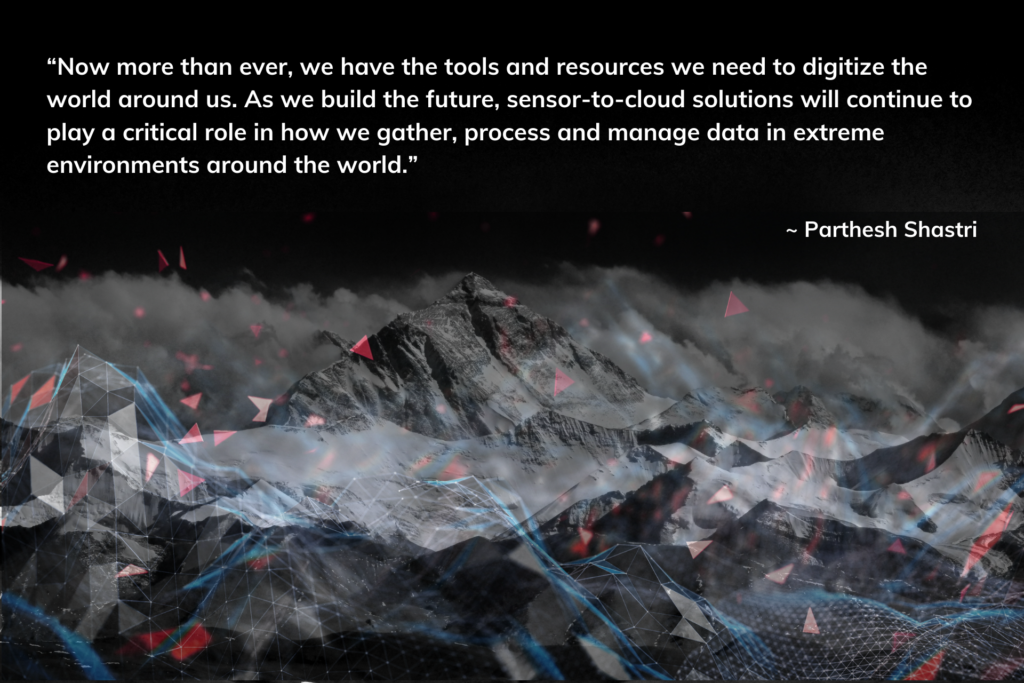
Technology – from Mount Everest to the farm It’s amazing what technology can do when paired with human will. Just a few years ago, a team of scientists made history as they trekked up Mount Everest with the goal of running environmental studies. With backpacks full of sensors (which included FreeWave technology), these men pushed boundaries to create a new normal. When we intentionally use modern technology to our advantage, we can create better, safer and more productive environments within every industry. Today, the same technology used on Mount Everest is now powering multiple earth science programs transmitting sensor data from remote environments to earth scientists, climatologists and meteorologists through cloud servers. This is just one example of many where sensor-to-cloud solutions have transformed our ability to interact with extreme environments in the modern world. A deeper look at extreme environments Typically, when someone thinks of an extreme environment, they imagine harsh, rugged terrain in a far-off remote location; however extreme environments aren’t limited by this definition. Take a large farm, for example, with a multitude of deployed assets and equipment across hundreds of acres. Traditionally, an operation like this requires an employee to physically check on the farm equipment multiple times a week, manually turning valves on and off, in addition to monitoring and controlling the overall farm environment. These day-to-day tasks are not only time-consuming but physically draining. In this case, the operational output required on the farm makes it an operationally extreme environment, and extreme environments are just one space where sensor-to-cloud solutions shine. Sensor-to-cloud in the real world Today, sensor-to-cloud systems utilize deployed sensors to collect and transmit data from remote locations. These sensors send the gathered information back to cloud servers for further research and analysis, enabling entire teams to utilize their limited time and resources more effectively. With sensor-to-cloud systems, we eliminate the often-laborious mechanics of middlemen procedures so that industry leaders can focus on what matters most. Let’s revisit that farming example. With sensor-to-cloud technology, farmers can automate the repetitive tasks of their operations. Something as simple as discrete soil sensors further allow farmers to virtually monitor their crop health, creating more time and space to focus on other high-value tasks. This gives them time, often an invaluable asset, to do what’s needed. In a sense, we can improve the productivity of an operation with an automated suite of sensor systems. Imagine the difference a network of sensors can make. The FreeWave difference For several years now, FreeWave products have been a leading resource solution for extreme environments. Our sensors were a part of the great Mount Everest expedition, and today, we have deployed sensors in many areas, including pipelines in Alaska, ice shelves in Antarctica, smart farms across the country and many other locations – rugged and traditional. We are providing the groundbreaking technology needed to monitor data in extreme environments so that our partners and customers can make the best, informed decisions for their operations. As the Chief Technology and Product Officer at FreeWave, I am constantly amazed at the impact our products have on the world. We are working with some of the major brands of our time, helping them solve massive problems affecting society at large. Our technology solutions serve entire industries, like oil and gas, agriculture, transportation and traffic, as well as many others that contribute to the well-being of the globe. It is great to be a part of a company where we can say our products are a part of the solution for life’s essentials. Every day, we help industry leaders identify their pain points and provide them with a single pane of glass product solution that helps them see the data wherever they are without the drain of additional resources. Our rich portfolio of radios, gateways, cloud software and analytics allows us to stitch together a range of packaged ready to use applications that solve our customer’s problems through simple, turn-key solutions. Sensor-to-cloud in the future Data is everywhere, and now more than ever, we have the tools and resources we need to digitize the world around us. As we build the future, sensor-to-cloud solutions will continue to play a critical role in gathering, processing and managing data in extreme environments around the globe. As I look at the world before us, I see endless opportunities to continue to leverage technology and data to build a better and more informed life.
Technology Simplified: Leveraging Data in the New Digital Era
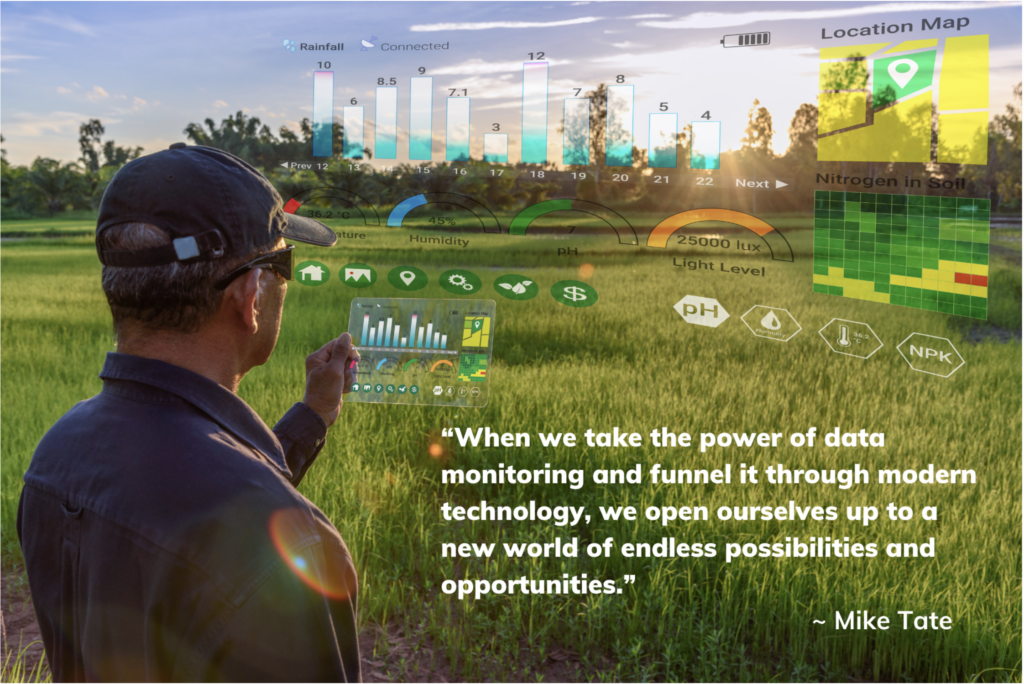
Excited by tomorrow, we face a new world filled with endless possibilities each day. Thanks to modern technology, simple sensors open the doors to our favorite restaurant, edge computing allows manufacturers to spot and correct production glitches before they happen, and high-tech traffic cameras analyze and record thousands of license plates daily to spot stolen and unregistered vehicles while also identifying suspected criminals. It’s no secret that the world is evolving before our eyes, and through the technological advancements of this digital era, we are creating a more efficient world. The power of data Data is a powerful tool of knowledge, and lucky for us, it’s everywhere! Every one of our actions is driven by a manual process of data – like the simple act of putting on a jacket when it gets cold, or an automated process of data – like a valve instinctively shutting off when a water tank gets full. Today we have the technology to effectively process, analyze and distribute data metrics in tremendously impactful ways. What does greater simplification look like for industrial leaders? Remote operations simplified When leveraged effectively, industrial internet of things (IIoT) solutions take remote operations to the next level, simplifying the work process for teams and industries across the globe. Think about some of the most popular high-value remote assets today, like drones, video surveillance, or even center pivot irrigation systems – these entities perform so well because they do what humans can’t. In mere seconds, IIoT technology can process, distribute and respond to data that would otherwise take an entire team hours, days or even weeks to achieve. In the not so distant past, industrial operations relied solely on data consumption (i.e., how much water is in the tank; what temperature is the water), but today, advancements give us the ability to respond nearly instantaneously to that collected data with actionable execution. Today we can view and control the management of an entire operation remotely on our cell phone. We can see how much water is in a tank or what temperature that water is at and automatically change and adjust the water levels and temperatures from near or far. As a result, the amount of time, resources and energy needed to run businesses has transformed entirely, and this evolution allows us to create an enhanced world and standard of work. Simple deployment Remote operations are oftentimes in rugged terrain, making them difficult or even impossible to access. At FreeWave, we solve this complex issue by providing pre-configured ready-to-deploy solutions, complete with everything needed to achieve the mission at hand. For example, through FreeWaves’s joint venture with ModuSense, we’re simplifying connectivity to cloud with a variety of pre-configured and ready to deploy monitoring and sensing solutions by supplying the entire solution with a 12-month data plan, dashboard, 12W rapid recharge solar panel, satellite connectivity and Bluetooth connectivity. You can use your mobile phone to validate the data directly from the gateway without having to wait for satellite transmission. We all know the “gotchas” when it comes to buying technology. Simple deployment means you’re ready from day one, without needing to buy additional components. Real-world impact As Chief Operating Officer and SVP of Global Sales and Marketing at FreeWave, I get a front-row seat to the real-life impact modern-day technology is having on lives, businesses and entire industries. The essentials of life have become simplified, and in the process, more people and businesses receive greater access to the things that matter most like critical information, metrics and potential outcomes. Creating a more sustainable world and preserving natural resources like food, air, energy and water have been at the forefront of IIoT since FreeWave began almost three decades ago when we brought long range, low power consumption, C1D2, 900 MHz connectivity and radio technology products to our customers. Since then, our connectivity options have greatly expanded by adding EDGE Compute, Software, Industry Protocol Conversions, Data Broker & Cloud, a complete end to end solution and with it comes the responsibility for greater environmental stewardship. We’ve all seen the devastating impact an environmental catastrophe, like the 2010 Deepwater Horizon oil spill, can have on the globe. Simple mistakes can and do cause enormous repercussions that affect us all. The truth is, with human interaction there will always be the cost of time and possible room for error. Technology, however, is different, as it allows us to not rely solely on human capacity and depend more on interconnected and advanced systems. Now, we don’t have to wait for someone to run into a situation or crisis and manually pull a lever or travel to turn off a valve. Instead, preprogrammed automation or a simple click of a button or flip of a switch from virtually anywhere in the world can control your high value remote assets. FreeWave is a technological pioneer in the 21st century. We have connected the unconnected with a reliable ecosystem of edge intelligent radios and solutions to optimize the extreme edge of remote industrial operations. Through our single IIoT platform, we provide expanded capabilities for data capture, analysis, control and automation. Our single pane of glass approach provides a simple, single vendor, one-stop-shop solution for remote operations worldwide. At the end of the day, when we take the power of data monitoring and funnel it through modern technology, we open ourselves up to a new world of endless possibilities and opportunities. It’s one thing to have data; it’s an entirely different thing to know how to leverage that data. At FreeWave, we are constantly pushing the boundaries of data monitoring and modern technology through our IIoT solutions and creating a better, safer and faster world of work for industries around the globe.
Data Connects Life: A Deeper Look at the Power of Connection for IoT Champions
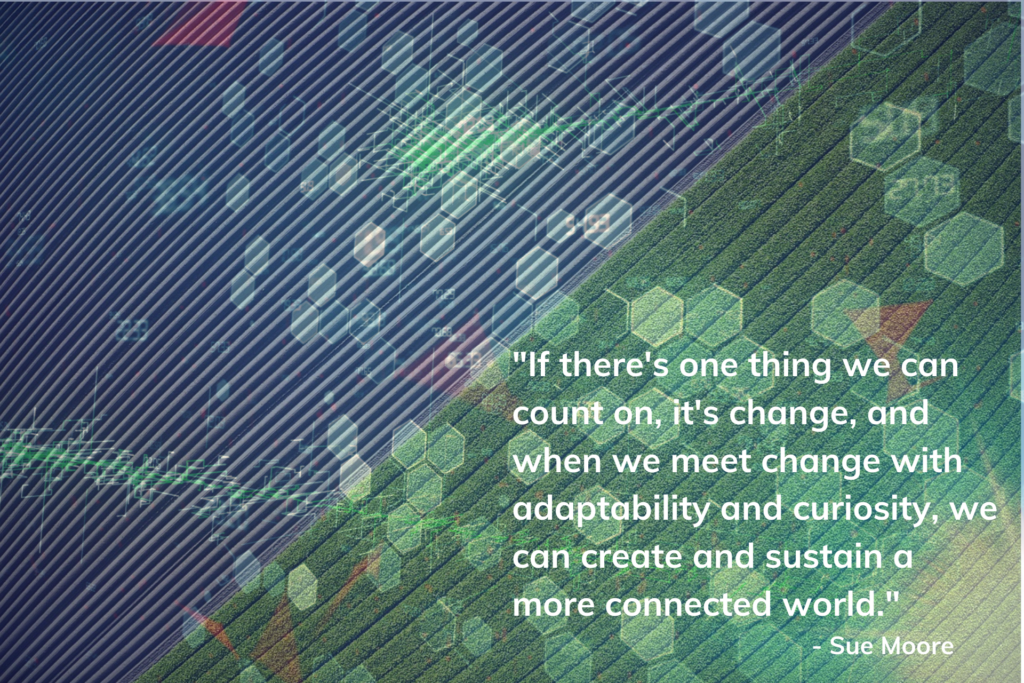
Every day, the world shifts in a new digital direction, making our lives simpler and equally more complicated all at the same time. I can vividly remember the introduction of email. I had just started my career in tech, and I kid you not, my coworkers and I questioned the efficiency of this new digital communication system. Back then, taking the time to craft an email, when I could easily make a phone call or walk to the office next door, felt foreign and unproductive, but now, decades later, I can’t imagine my life or work without the power and ease of email communication. If there’s one thing we can count on, it’s change, and when we meet change with adaptability and curiosity, we can create and sustain a more connected world, one where technology invites us to innovate, collaborate and engage with each other and the environments we live in! More technology. More data. The Mckinsey Global Survey has found that our global response to the pandemic has accelerated the rate of technology by several years. What does that mean for real people? Over time, we have discovered a new world filled to the brim with data that both informs and transforms our day-to-day lives. From smartphones to traffic management systems, the Internet of Things (IoT ) is revolutionizing life as we know it, connecting us to more people, places and systems than ever before. Connection is a powerful tool, and when harnessed effectively, it can change the world. The interdependent relationship between our natural and digital world is quite profound; in today’s society, we operate as one. In smart agriculture, for example, effective data can make a significant difference in overall crop and herd health, which, in the end, affects us all. Whether we’re on the farm, on an oil rig in the middle of the ocean or in our own backyards, technology connects us. Data is everywhere, and when this data is measured and distributed carefully, it transforms entire industries. Accessing the data you need on your terms For the last 28 years, FreeWave Technologies has pioneered a unique IoT revolution, reinventing the way industrial IoT is used in the modern market. We connect the unconnected with a reliable ecosystem of edge intelligent radios and solutions to optimize the extreme edge of remote industrial operations. Through our software, we provide IoT champions with real-time data insights to create better and more sustainable businesses. To achieve transformative operational optimization, industrial leaders need visibility into data and the ability to proactively manipulate that data and act on the insights gained from it. Our vision is to build an ecosystem of edge intelligent radios and solutions to transform the extreme edge of industrial operations into a connected part of their enterprise. Our integrated edge connectivity and computing solutions provide expanded capabilities for high-fidelity data capture, analysis, control and automation via a single industrial IoT platform that is readily scaled as each edge computing need evolves. We call it a single pane of glass. With a legacy of solving thousands of customer changes across multiple industries and deployment in 39 countries, the goal is to continue to future-proof operations so that remote work becomes more autonomous and, dare I say, simpler. It all brings us more connected with our collective purpose to create a better and more sustainable world. Data connects life. The more we see, the more we understand, and the more we understand, the more equipped we become to make better decisions. As the Director of Marketing at FreeWave, I am closely connected to the people and operations most impacted by our work. I know firsthand how powerful connection is for the IoT champions we serve, and every day I witness the power of data to transform the world. Putting it in perspective Take the water and wastewater industry, for example; in this industry, clear and controllable data insights are key to achieving effective operational management. At FreeWave, we provide these actionable data insights such as moisture levels and weather predictions through our sensor and weather monitoring technology, which ultimately allow water and wastewater industry leaders to be proactive in their business rather than reactive. A proactive and informed approach to operational management makes the difference in creating a more sustainable environment, and a more sustainable environment transforms our communities and the surrounding world. FreeWave’s productivity technology is removing barriers to data and helping industry leaders solve unique challenges like never before. Where some people may only see tech software – a little box with some wires, chips, and sensors – a much deeper reality occurs. We are all connected, and today, IoT champions get to leverage the power of this connection, along with technology and data, to create a better world, one industry at a time. I am so proud to work for a company that is connecting the world in unique and innovative ways. Every day, I see the impact of technology and what it means to be more connected through data, giving us critical insight. What we do with that data is where the magic happens. This is where we can use connectivity to push boundaries for greater innovation, make best use of our people, create safer work environments by understanding what’s happening in hard-to-reach terrain, and even take bold action to architect a more sustainable world.
IIoT For Electric Utilities: The Past, Present, and Future

Electric companies are poised to become future IIoT leaders. Here’s why. Primarily driven by Advanced Metering Infrastructure (AMI), the Industrial Internet of Things (IIoT) has fundamentally changed electric utilities. Technologies that let devices act as two-way communicators between consumers and utility providers paved the way for new opportunities. Digital transformation is here, and businesses have to reinvent themselves to stay competitive and relevant. Still, many electric utility providers aren’t ready to leap into Industrial 4.0. Why? Because adopting and integrating smart tech into legacy IT and OT infrastructures can seem daunting. Learning new skills is challenging and takes time, and potential setbacks, like unplanned downtime, can leave utility leaders fearful. Many utility leaders are riddled with doubts regarding the technological uncertainties of IIoT. It’s understandable. With rapid growth come growing pains. The IIoT journey from uncomplicated AMI to vast, smart grid expansions is challenging. Urbanization is quickly expanding, energy prices constantly fluctuate, legislation is always changing, and sustainability is paramount. Because of this, utilities must refine their operations to meet evolving consumer demands for sustainable, affordable infrastructures. IIoT adoption won’t happen overnight, but you have to start somewhere. Here’s how: Introduce real-time monitoring equipment like sensors, readers, and alarms into your operations. And use technology to automate processes, conserve resources, improve outcomes, and eliminate downtime. Still, understanding how IIoT can impact your business is a great place to start. How can IIoT solve your problems? The benefits of IIoT are hard to ignore. Almost no one would balk at real-time data collection or say “no” to monitoring critical system health. Who would pass on the opportunity to improve efficiency and safety? Almost no one. Let’s face it. Competition is stiff, and unhappy customers create churn. Cost and efficiency drive consumers these days. They’ll switch providers with a simple click. Customer churn is inevitable if you can’t provide reliable service. That’s why your technologies must allow you to react in real-time. Seconds count when it comes to your customers. Connecting your devices, sensors, and alarms to the Internet, lets you monitor and utilize data in real-time to: Increase efficiency Use automation Reduce errors Work remotely Enhance security Boost profits Make better decisions These are benefits you can’t afford to miss. Implementing IIoT is a surefire way to open personalized customer communication. IIoT lets you tailor services to specific customer demands. We can’t understate the value of using edge technology and wireless connectivity to remotely operate, analyze, and optimize your electric utility operations. As energycentral.com points out, “utilities who refuse to adapt or change will suffer financial losses, countless preventable maintenance issues, and a waste of resources.” How can utilities lead the next wave of IIoT? IIoT is how power and utility providers will operate in the future (many already are). Traditional energy production and distribution methods are obsolete, and the days of manual processes and zero real-time visibility are over. IIoT is transforming how utilities run vast, widespread, and remote operations, and internet-connected devices and machines are reshaping the ways utilities operate. Technology never stops evolving, and transitioning into Industrial 4.0 and IIoT isn’t an option anymore. The pandemic increased automation and digitization demands, producing a ripple effect that’ll extend into the future of IIoT. Utility companies are partnering with tech companies to create innovative solutions to improve sustainability and become more efficient. As IIoT adoption accelerates, the opportunities to provide amazing service increase exponentially. With IIoT, utilities are proactive instead of reactive. And predictive maintenance through AI lets utilities continually learn and optimize operations. It’s a new era in the power industry. And smaller utilities are outpacing massive corporations. Smaller, more agile businesses are transforming the industry with their smart business models. And these same small businesses pose a threat to established corporations digitally transforming too slow. Providers that embrace IIoT will emerge as utility leaders in the next several years. Put your business and your customers first. You can’t afford to not implement IIoT into your electric utility operations. It’s time to put your business and your customers first FreeWave is second to none when it comes to proven IIoT solutions and making the most of your data. We’re the leaders in edge computing and wireless connectivity. We’ll accelerate your digital transformation. Our technologies are fast, flexible, and easy to deploy. We’ll have you leveraging IIoT, big data analytics, and connectivity to take the guesswork out of your operations in no time. And you can do it all without a complete infrastructure overhaul. You’ve been improving your utility operations for years; why stop now? We want to take your operations to the next level. Get in touch; let’s chat.
Connect Field Assets Together with Node-RED App Dev
Until recently, modern solutions for remote process-control and automation applications were limited to expensive retrofits, recurring subscription fees, and costly internal software development. Small- to medium-sized businesses often struggle with the balance of enabling these critical monitoring and control functions, while also focusing on the bottom line. Fortunately, the rise of open source software development has introduced new solutions that finally offer a more affordable option, with rapid ROI and measurably reduced OPEX and CAPEX. These solutions combine process-driven industrial app and edge intelligent platforms that can be implemented easily and affordably. These platforms achieve enterprise-level process control, monitoring and automation by combining 900 MHz wireless telemetry with the ability to program and host third party apps for intelligent control and automation of remote sensors and devices. Picture a Linux-based Raspberry Pi embedded in a robust industrial Ethernet radio. The beauty of these solutions is that they are designed for both experts and novices in the app dev space. Developers can program with any language that is compatible with a Linux kernel. Node-RED, in particular, has proven to be especially successful with the novice developer crowd, enabling fully functioning and visible small SCADA solutions that solve a variety of issues for small- to medium-businesses, namely the cost reduction of installation, maintenance and upkeep of more expensive hardware solutions. With Node-RED, Industrial IoT (IIoT) apps are easily designed and hosted on the radio at the edge of the network – offering local intelligence, analytics and process control to cloud-based systems. These apps have even raised the possibility of eventually serving as SCADA replacement. The programming possibilities are endless and the needs are vast, opening a significant opportunity for IoT developers to create apps that can be executed at the edge. This impacts many industries, but especially those with remote or geographically dispersed networks, such as those in oil and gas, precision agriculture, utilities, water/wastewater, and government/defense. In water/wastewater, for example, we’re already seeing the implementation of a Node-RED, complex water utility app. Node-RED Complex Water Application When a water utility has dispersed assets, such as tanks that are a large distance apart, there is a Node-RED SCADA app available that allows orchestration of both manual and automatic control of the system directly from the app dashboard without using expensive logic hardware. The Node-RED SCADA app also enables real-time alerts to potentially dangerous or damaging events via text or email – directly to their mobile devices. This is easily executed under Nod-RED programming and here’s a demonstration of how it works: With the edge intelligence and process automation delivered in a programmable platform we’re already seeing increased uptime and lower on-site maintenance costs because of the enhanced ability to monitor and troubleshoot remotely. Because data is acted upon at the sensor, these edge intelligent and process automation platforms solve problems, remotely, that are not easily solved with traditional hardware solutions. As we look towards the next generation of SCADA, it’s looking a lot more affordable and flexible. What types of apps would you like to see for water/wastewater?
IIoT News Roundup: How IoT is Saving Lives

In the past several weeks, there have been two massive natural disasters in the U.S., as Hurricane Harvey made landfall in Texas, bringing historic flooding to Houston and surrounding areas, and Hurricane Irma devastated parts of the Caribbean and Florida. Sadly, thousands of people find themselves without power, food and shelter. It is indeed a terrible tragedy and our hearts go out to those affected. In this devastation, however, there is a story emerging about the role the Internet of Things (IoT) has played in disaster preparedness. Indeed this technology has matured to the point that it is making a real and measurable impact in helping communities prepare for, respond to, and recover from disaster. In today’s IIoT news roundup, we will take a look at several stories emerging around disaster preparedness, smart cities and the IoT. Disaster Response in the 21st Century: Big Data and IoT Saves Lives In this story from Forbes, author Chris Wilder describes some of the ways the IoT and other technologies have changed the way disasters are predicted and responded to. Specifically, Wilder cites the ways crowd sourced emergency applications have made post-disaster communication and emergency dispatch easier and more streamlined. Further, Wilder speaks to the ways Big Data generated from sensors and meters throughout the region helped give more advanced notice to impacted areas and helped predict the path of these hurricanes with greater accuracy. IoT’s Role in Natural Disasters like Harvey In this article from IoT for All, author Hannah White discusses how the advent of the IoT has fundamentally changed the way hurricanes are predicted and responded to. Specifically, White discusses how open data was used to list Red Cross shelters with space availability, as well as evacuation routes that remained passable. White also describes the way organizations are leveraging drone technology in their response. Oil and gas companies are using drones to inspect their facilities, while insurance companies have been able to use the tech to capture high-resolution 3D images of damage to help expedite claim response and enable those affected to rebuild and recover more quickly. Finally, White discusses the way different organizations are leveraging IoT sensor arrays to measure and predict natural disasters in advance, helping to provide critical time to those in harm’s way. Where Will Hurricane Jose Go Next? How Drones and Lightbulbs Help Predict Dangerous Weather Unfortunately, Irma and Harvey are being quickly followed by another potentially dangerous storm (at the time of writing, Tropical Storm Jose) looming east of the United States. In this article from Newsweek author Kevin Maney describes the ways technology is helping us predict storms with greater accuracy. In the article, Maney notes the one of the key components for more accurate weather modeling and prediction is vast amounts of data. Indeed, the IoT is the most prolific and advanced data engine in technology history, and scientists are able to leverage the IoT to make incredible breakthroughs in their weather modeling algorithms. Department of Energy Investing in Power Resiliency In this recent blog post from the Department of Energy, it was announced that the DOE is invested some $50 million to help improve the resilience and security of the United State’s energy grid. This is a particularly timely announcement in the wake of Harvey and Irma, whose impacts on area electrical grids were profound. One of the technologies in discussion as part of the investment are micro grids, smaller, more “agile” energy structures that make the impact of localized storms less widespread. In a traditional grid system, one transformer can impact wide swaths of residents, while a micro grid limits damage and makes repairs simpler, less costly, and faster. Final Thoughts While the devastation caused by these two natural disasters cannot be overstated, IIoT played a significant role in saving lives both before the storms made landfall and after the storms had passed. When it comes to these sorts of disasters, even minutes of additional notice can mean the difference between life and death. As IoT solutions grow more robust and continue to become more ubiquitous in cities across the globe, we expect prediction and response capabilities to continue to advance at an incredible pace.
Microgrids Gaining Mainstream Traction
While “going off the grid” is not a new term, microgrids are finding new footholds in a changing utilities industry. Recently, more and more cities and states are turning to microgrids not only as highly effective ways of increasing energy resiliency, but also as pragmatic and cost effective strategies for shifting population densities and energy consumption behaviors. Below, we’ve gather some of the top recent headlines on the changing microgrid landscape. Microgrids In New Applications Microgrids have long been viewed as an excellent tactic for supplying power to rural areas and island communities. However, recent data shows that microgrids may be expanding. This article from the Motley Fool, notes that governments and correctional facilities are turning to micrograms as viable options for emergency backup power. Another area where microgrids are seeing growth is in use for growing suburbs and rural areas. In the past, power companies has to build costly new transmission lines to service growing population areas, lines which may only be used during peak demand for a few hours a year. By leveraging microgrids, energy companies can build cost effective solutions for dealing with rare power consumption spikes. Communities Turn to Microgrids for Energy A recent article from Electric Light & Power notes that there are developing plans to build 13 microgrids across the state of New Jersey to increase the areas energy resiliency and better prepare the state for emergency situations. The effort, spearheaded by New Jersey Board of Public Utilities President Richard S. Mroz, has been prioritized in the wake of the devastation caused by Hurricane Sandy, during which many areas were left without electricity and running water for weeks on end. One of the proposed microgrids in downtown Trenton would connect several important government buildings, helping keep the cities most essential resources up and running even during emergency situations. Building a Carbon Free City In the stretch of land between the city of Denver and its airport, a new town is being built that will rely solely on a microgrid for power — and it will be completely carbon free. The city, called Peña Station Next, will rely primarily on solar energy and is receiving large financial support from the city of Denver. As reported in this article from The Scientific American, the city will rely “mainly on solar energy, a king-sized lithium-ion battery and various energy efficiency schemes” for its power. Will Battery Tech Change Microgrid Strategies? Batteries are getting bigger — so what does that mean for microgrids? As noted in this article from Teslarati.com, Neoen and Tesla recently announced the creation of a 100MW/129MWh battery adjacent to the Hornsdale wind-farm in South Australia. One of the claims Tesla had in building the battery is that the company could make money by providing off-the-grid backup power. According to the article, however, this might not be so simple. Bruce Miller, a principal consultant for Advisian, says the 80-minute discharge time for Tesla’s system isn’t in line with 10-megawatt- and 20-megawatt-hour systems that could produce $2.1 million a year from supplying backup energy. Brooklyn is On-Board with Microgrids Brooklyn, the dense suburb of New York City, is one of a growing list of major population centers to explore microgrids. As noted in this article from Green Biz, Brooklyn is exploring a strategy where a virtual web of buildings whose owners can buy and sell power to each other using blockchain technology to manage the transactions. Currently, the program has hundreds of participants signed up, and users will ultimately be able to control their participation through the use of an app. With more governments and power companies exploring the promise of microgrids, it may only be a matter of time before a microgrid is a viable primary or emergency energy option for many. Where do you see microgrids growing next?



